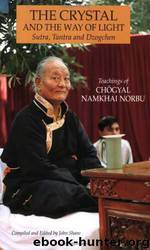The Crystal and the Way of Light: Sutra, Tantra and Dzogchen by Chogyal Namkhai Norbu & John Shane

Author:Chogyal Namkhai Norbu & John Shane
Language: eng
Format: azw3
ISBN: 1559391359
Publisher: Snow Lion Publications
Published: 1986-06-29T00:00:00+00:00
The function of the Ngondro is to allow the disciple to purify him or herself and to accumulate merits, so that he or she may approach the Way of Wisdom, and the practice of the Ngondro should deepen his or her commitment, make him or her more humble, increase his or her devotion toward the root-master, and, finally, allow for the surpassing of the disciple's dualistic mind in the unveiling of the state of the master in the student. If the practitioner's intention is not perfect, the Ngondro will not fulfill its purpose; in particular, if it is undertaken with the attitude of wishing to acquire a `passport', instead of allowing the individual to accumulate merits and to purify him or herself so that he or she may obtain wisdom, it will cause the individual to develop more pride and a false sense of superiority.
Kyerim and Dzogrim
Tantric practices may be used as secondary practices by the practitioner of Dzogchen, alongside the principal practice of contemplation. All tantric practice works with visualization, but in the Inner Tantras (also called Higher or Anuttaratantras in the three later schools of Tibetan Buddhism), the practitioner must reintegrate her or his dualistic existence into the nonduality of the primordial state by using inner yogic practices as well as visualization. The process of developing the visualization is called Kyerim, and the work with inner yoga is called Dzogrim, which mean `Development' and `Completion' stages respectively. By means of these two stages the impure karmic vision of the individual is transformed into the pure dimension, or 'mandala', of the divinity into whose practice the master has initiated the disciple. Mantra are recited as part of this process-mantra being the natural sound of the dimension of the divinity, which thus function in practice as the vibrational key to that dimension. It is essential to receive transmission of mantra from a qualified master, or they will not function.
While physical yoga has no important role in Hinayana and Mahayana Buddhism, in Tantric Buddhism, also known as the Vajrayana (Indestructible Vehicle) or Mantrayana (Mantric Vehicle), it is a fundamental means for realization. While the Indian form of Hatha Yoga is well known, it is not so widely appreciated that there is a specifically Tibetan form of Yoga based on the Inner Tantras (or on the Higher tantras in the schools other than the Nyingmapa).
Download
This site does not store any files on its server. We only index and link to content provided by other sites. Please contact the content providers to delete copyright contents if any and email us, we'll remove relevant links or contents immediately.
The remains of the day by Kazuo Ishiguro(8815)
Tools of Titans by Timothy Ferriss(8211)
Giovanni's Room by James Baldwin(7188)
The Black Swan by Nassim Nicholas Taleb(7009)
Inner Engineering: A Yogi's Guide to Joy by Sadhguru(6722)
The Way of Zen by Alan W. Watts(6503)
Asking the Right Questions: A Guide to Critical Thinking by M. Neil Browne & Stuart M. Keeley(5629)
The Power of Now: A Guide to Spiritual Enlightenment by Eckhart Tolle(5603)
The Six Wives Of Henry VIII (WOMEN IN HISTORY) by Fraser Antonia(5394)
Astrophysics for People in a Hurry by Neil DeGrasse Tyson(5130)
Housekeeping by Marilynne Robinson(4328)
12 Rules for Life by Jordan B. Peterson(4249)
Double Down (Diary of a Wimpy Kid Book 11) by Jeff Kinney(4204)
The Ethical Slut by Janet W. Hardy(4172)
Skin in the Game by Nassim Nicholas Taleb(4161)
Ikigai by Héctor García & Francesc Miralles(4123)
The Art of Happiness by The Dalai Lama(4063)
Skin in the Game: Hidden Asymmetries in Daily Life by Nassim Nicholas Taleb(3929)
Walking by Henry David Thoreau(3892)
